-
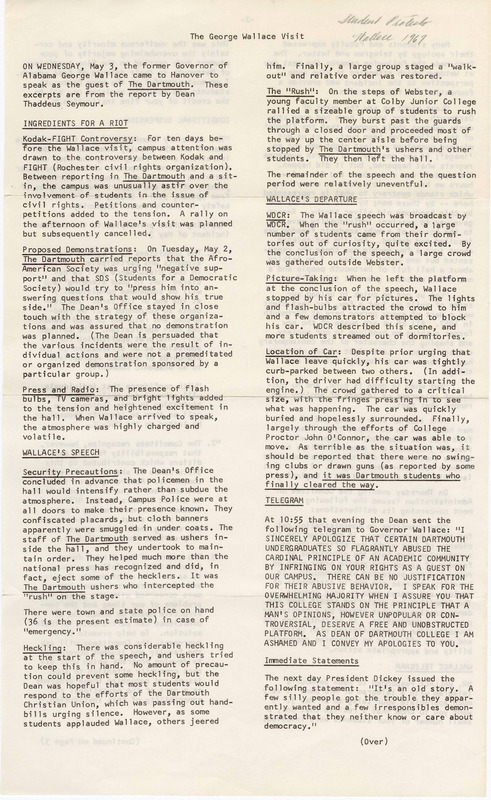
Excerpts from a report by Dean Thaddeus Seymour about George Wallace’s May 1967 visit to Dartmouth as a guest speaker of The Dartmouth student newspaper.
-
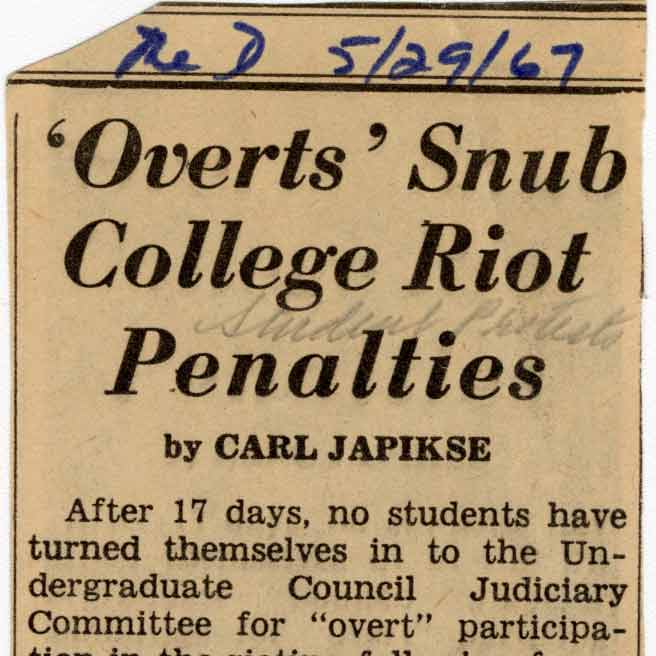
This article reports that no student participants in the demonstration against George Wallace had come forward to admit their involvement to the Undergraduate Council Judiciary Committee after 17 days of having the opportunity to do so. James E. Topinka ’68, chairman of the Judiciary Committee remarks that he doubted if any students would turn themselves in under risk of temporary suspension but hoped “the community... learned a lesson from the whole affair and that’s what’s important.”
-
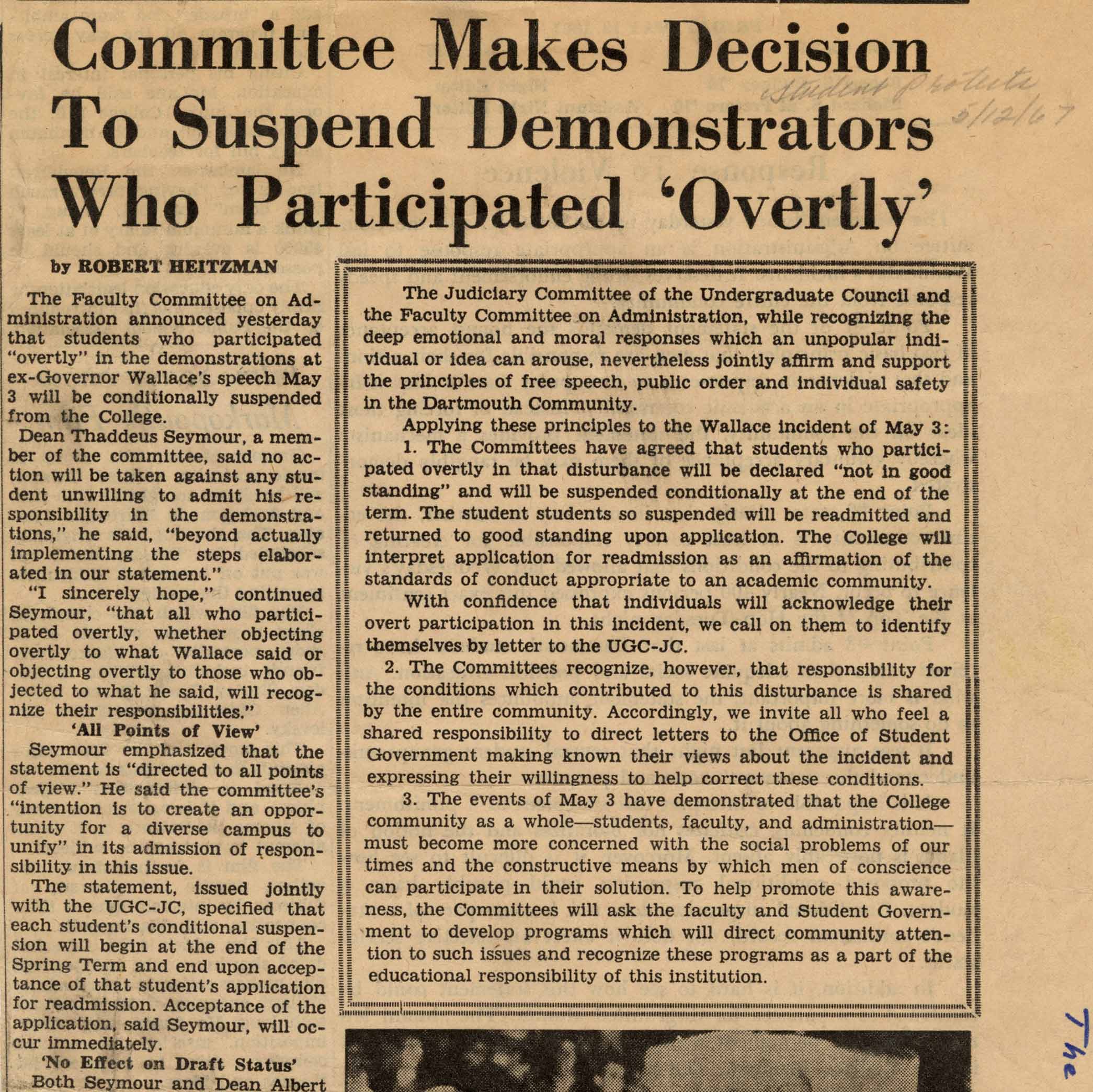
This article by Robert Heitzman details the Faculty Committee on Administration’s decision to conditionally suspend Dartmouth students who participated ‘overtly’ in the demonstration against George Wallace’s speech in Webster Hall. In addition to hoping students who demonstrated would come forward to admit their involvement, the article remarks that the Committee recognized that “responsibility for the conditions which contributed to this disturbance is shared by the entire community. Accordingly, we invite all who feel shared responsibility to direct letters to the Office of Student Government making known their views...” Dean Thaddeus Seymour hoped such actions would “create an opportunity for a diverse campus to unify.”
-

The Valley News covers the proceedings of a joint student-faculty panel discussion held in the Hopkins Center to discuss the reasons for the student demonstration against ex-governor George Wallace’s visit to Dartmouth earlier that month (May 1967). This article demonstrates the wide range of public opinion held by members of the Dartmouth community following the George Wallace protests, as well as the efforts made to build a more empathetic campus in the aftermath of the protest. Journalist Jerry Robinson argues that Wallace took advantage of the Dartmouth community, stating that “[he] had nothing to lose by coming here;” either Wallace would be heckled by students and gain more sympathy among his supporters, or he would publicly assert that the absence of such a demonstration was evidence that his racist policies were popular in a “sedate New England community.”
-
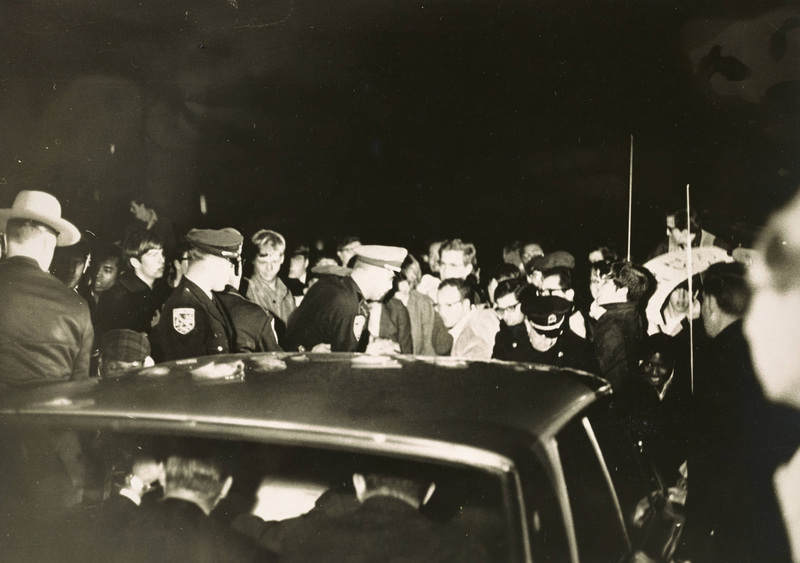
This photograph depicts students and police officers surrounding former Alabama Governor George Wallace’s car after he ended his speech early during his May 1967 visit to Dartmouth College. After the Southern segregationist was interrupted by a group of student protesters during his campaign speech to 1,300 Dartmouth community members, Wallace left Webster Hall with a throng of students who surrounded his car. This protest was later called “The Wallace Riot” as Wallace supporters and news outlets around the nation reported on the demonstration.
-
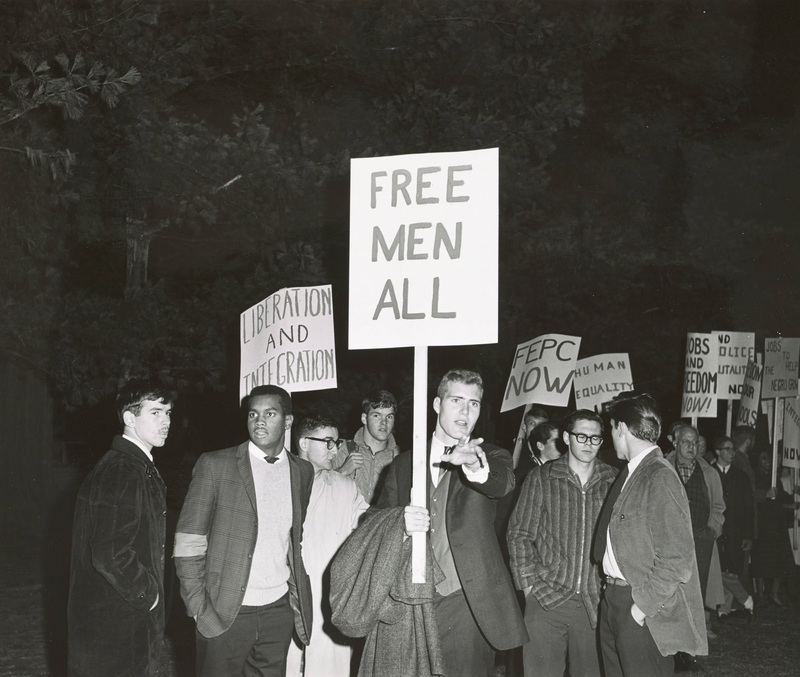
This photograph, captured outside of Leverone Field House during Alabama Governor George Wallace’s visit to Dartmouth on November 5, 1963, depicts Dartmouth students (including Richard Joseph '65) and Upper Valley community members protesting the segregationist's policies and views on race. Signs reading “liberation and integration” and “free men all” are raised in response to the politician’s recent inaugural address, in which Wallace stated, “segregation now, segregation tomorrow, segregation forever.” Additional signs reference FEPC, or the Fair Employment Practices Committee, which was established by President Franklin D. Roosevelt in 1941 to help prevent discrimination against African-Americans in defense and government jobs.
-

This photograph depicts Dartmouth community members protesting Alabama Governor George Wallace’s visit to Dartmouth on November 5, 1963. Signs reading “Equal Rights Now” and “Equality” are raised in response to the politician’s recent inaugural address, in which he asserted, “segregation now, segregation tomorrow, segregation forever.”
-
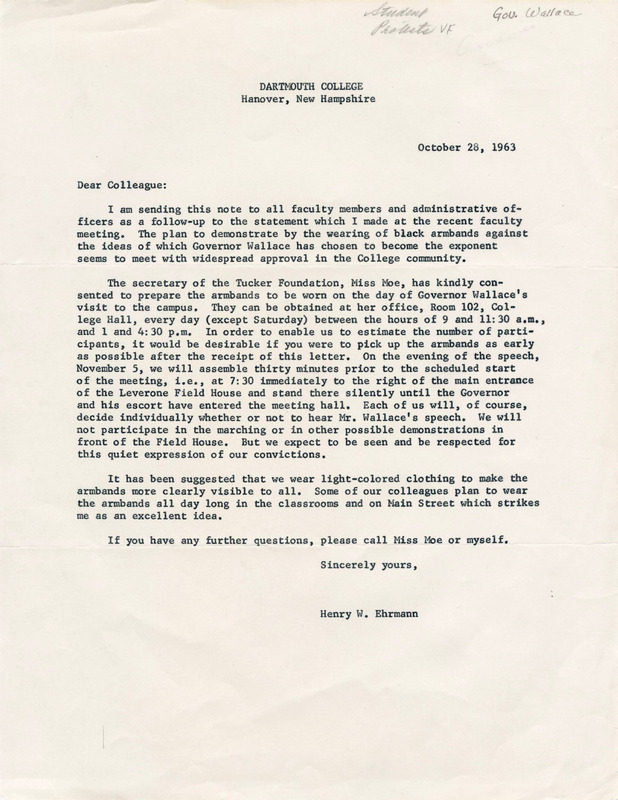
Henry Ehrmann writes to his colleagues of a plan to wear black armbands in silent protest of George Wallace’s upcoming visit to Dartmouth in 1963. Ehrmann urges those who wish to protest to wear light-colored clothing, so the armband is more visible, and indicates some faculty plan to wear armbands all day long in classrooms and on Main Street.
-
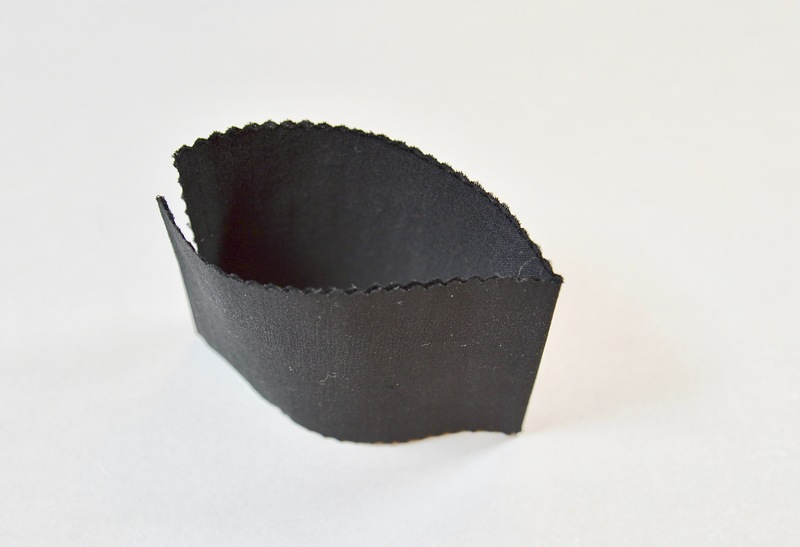
This black armband was worn by members of the Dartmouth College faculty in silent protest of segregationist George Wallace’s visit to Dartmouth in November 1963. Wallace, then the Governor of Alabama, made national headlines before his address in Leverone Field House for his unwavering support of “segregation forever.” In light of Wallace’s segregationist views, dozens of faculty members wearing black armbands assembled along the entryway as Wallace entered Leverone, and later wore them in classrooms and around town.
-
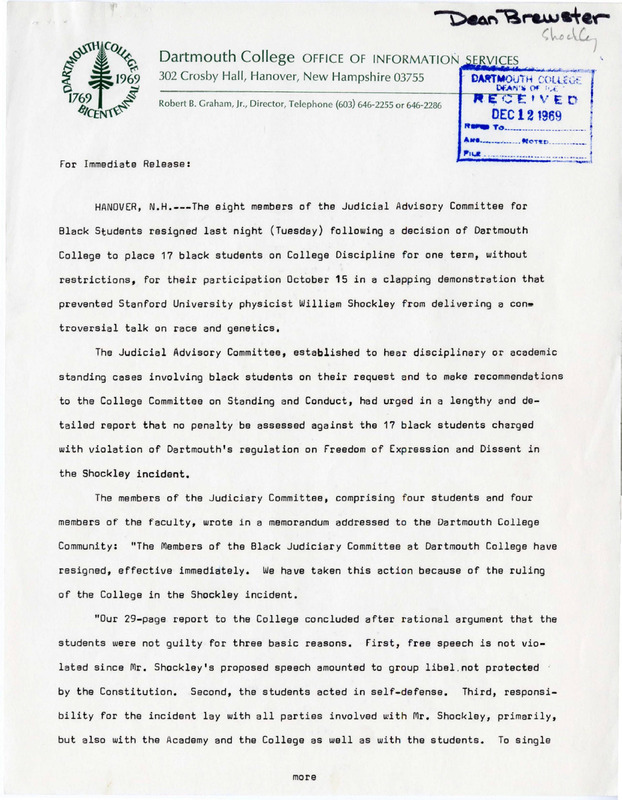
This press release announces the resignation of the four students and four faculty members that served on Dartmouth’s Judicial Advisory Committee (JAC) for Black Students following the decision of the College to place 17 black students on college discipline for their involvement in the clapping demonstration against William Shockley. The JAC statement recalls that their 29-page report concluded that the students should not be charged with any offenses on the grounds that Shockley’s speech amounted to group libel, the students therefore acted in self-defense. The JAC statement further explains that their decision to dissolve was made in part due to the College’s failure to answer any of the arguments put forth by the committee regarding the Shockley incident, therefore demonstrating that “further activities of the Black Judiciary Committee [are] futile” in conversations about race relations at Dartmouth.
-
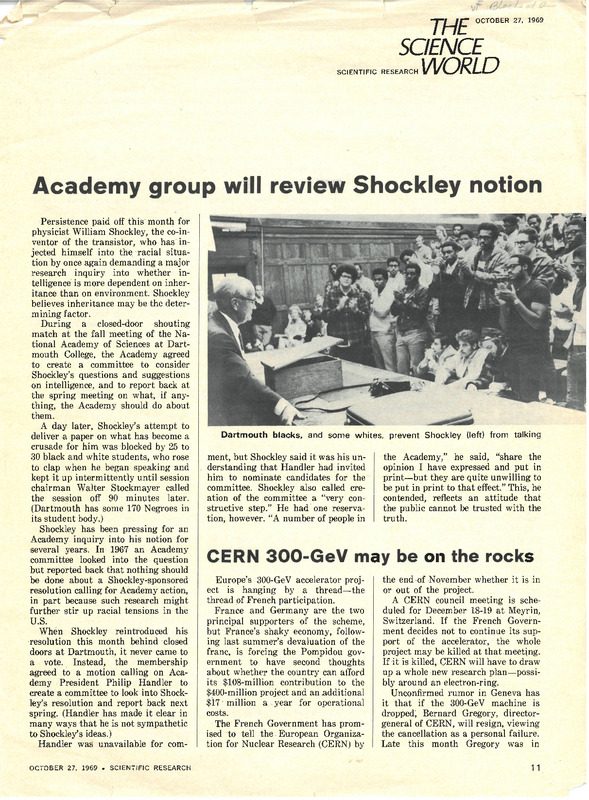
This article in Science World describes how the National Academy of Sciences created a committee to investigate whether human intelligence is more dependent on inheritance (i.e. race in this context) or on the environment, upon the request of physicist William Shockley. The article also details Shockley’s attempt to present a controversial paper examining correlations between IQ and race at Dartmouth, and how it was successfully halted by a group of 20-30 Dartmouth students who clapped intermittently for 90 minutes until the speech was called off.
-
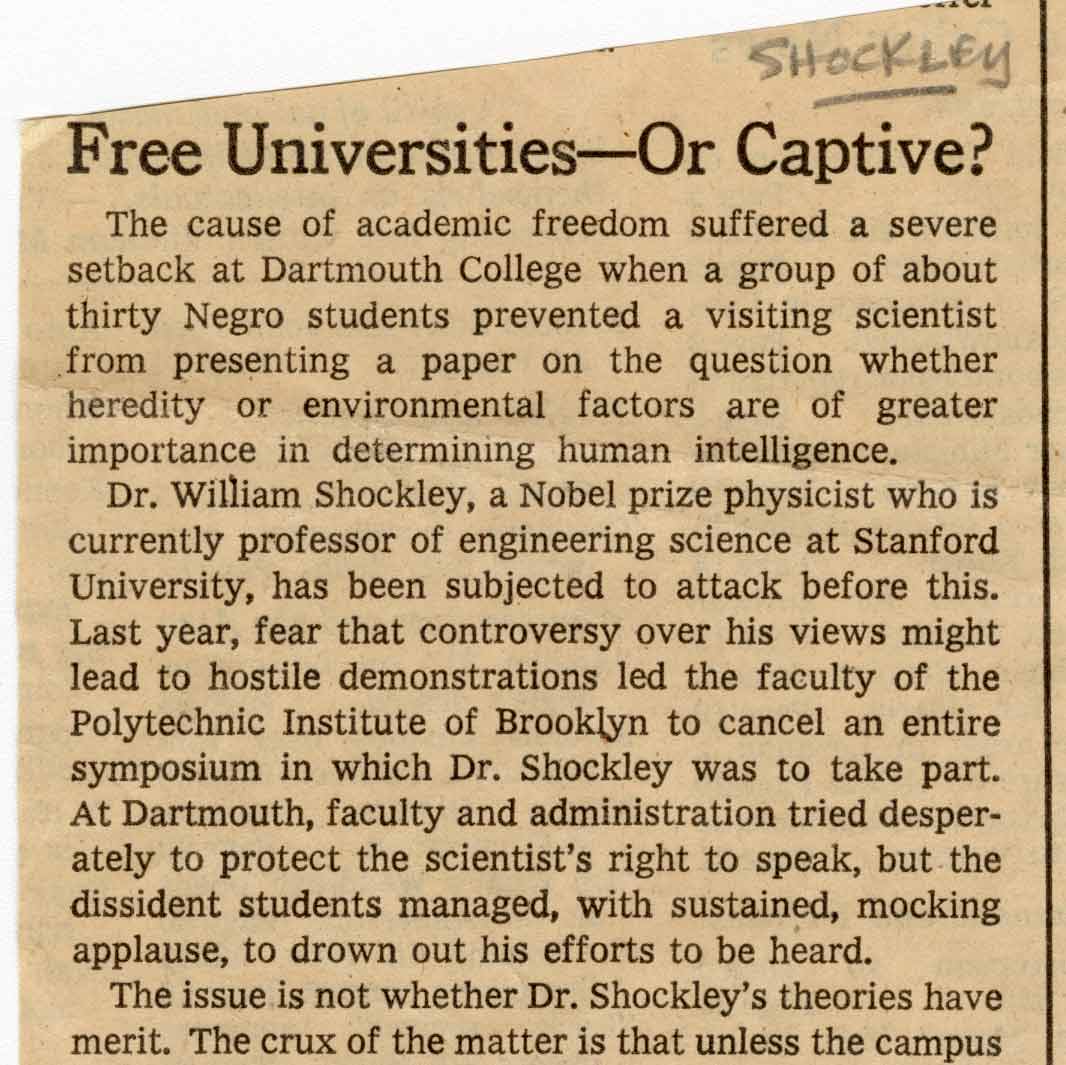
This New York Times opinion piece argues that the recent wave of demonstrations against physicist William Shockley represents a problematic trend in diminishing what the author calls “academic freedom.” The author argues that the increasing number of “politicized” demonstrations across American universities against racist speakers threatens the ability of campuses to “be kept open as forum(s) of ideas, no matter how controversial.” The author implies that Shockley should have been allowed to speak at Dartmouth, since universities ought to serve as “sanctuaries of freedom” for all ideas, no matter how injurious or unpopular.
-
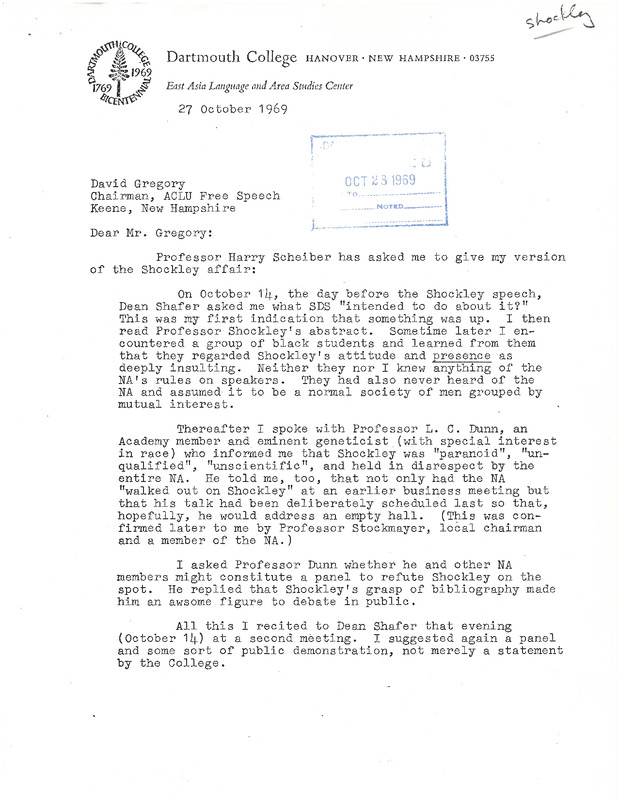
Prof. Jonathan Mirsky gives his perspective of the Shockley Incident to David Gregory, American Civil Liberties Union's Chairman on Free Speech. He explains that the National Academy themselves viewed Shockley with disdain and that "his talk had been deliberately scheduled last so that, hopefully, he would address an empty hall." Mirsky concludes his letter with his overall assessment and opinion "that by merely clapping, the blacks showed moderation [while] [t]he whites displayed inertia, insensitivity and perhaps a bit of cowardice."
-

The oral history interview of Charles F. Dey, Class of 1958, runs for approximately four hours and documents his time at Dartmouth, beginning with his undergraduate years, his tenure as Associate Dean, particularly his work partnering with private schools to recruit minority students, and developing the ABC (A Better Chance) program. The interview concludes with Dey's time as Dean of the Tucker Foundation, and the various programs he supported in those years, as well as comments on the changing culture of Dartmouth during the late '60s and '70s.
-

The oral history interview of Errol Hill runs for approximately two hours and includes the memories of Professor Hill and his wife, Grace Hill, of the climate for Black people living in Hanover and working at Dartmouth in 1968. They speak of Presidents Kemeny and McLaughlin and the events that took place during their administrations, the implementation of the College's Affirmative Action Plan, Professor Hill's work as head of the Drama Department, and the many productions he put on in the Hopkins Center.
-
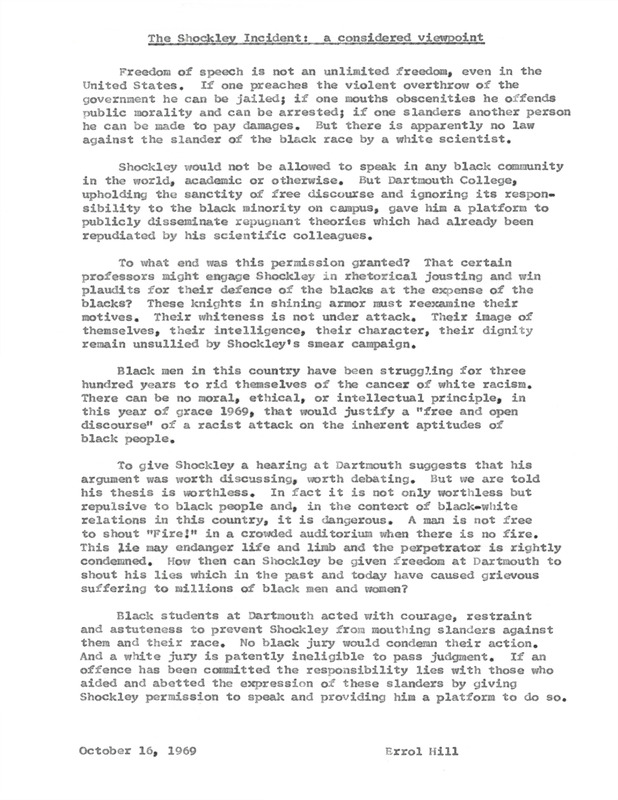
Dartmouth professor, adviser to the Afro-American Society, and Affirmative Action Officer Errol Hill posits that Nobel prize winner William Shockley should not have been permitted to present his controversial paper at Dartmouth College. Hill thought the paper's suggestion that there are correlations between intelligence and race was not only scientifically inaccurate but harmful to relations between members of the Black and white communities. He expresses his support for Dartmouth students who used peaceful protest to drown-out Shockley’s presentation.
-
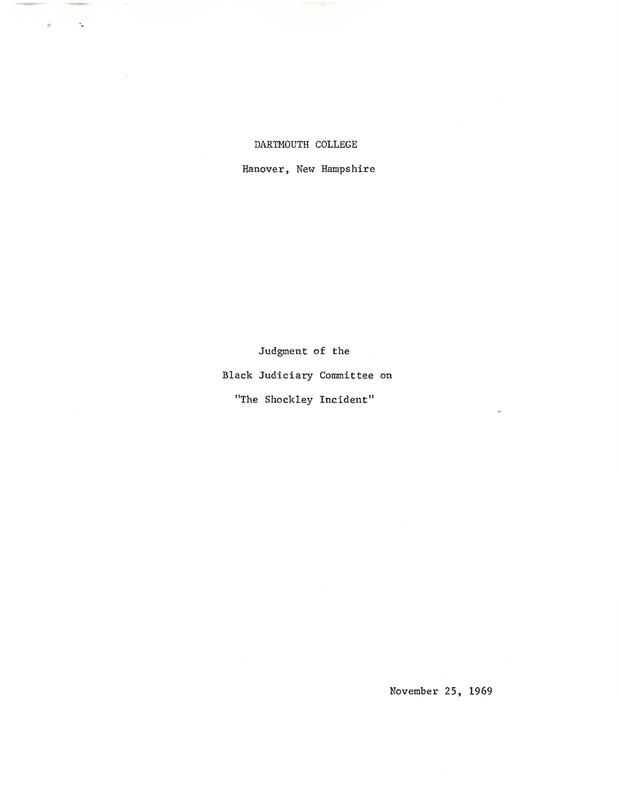
Members of Dartmouth’s Black Judicial Advisory Committee (JAC) recommend that no penalty be incurred against the 17 Black students who participated in a clapping demonstration during a presentation by Dr. William Shockley. They conclude that Shockley’s speech was “group libel,” attacking and defaming the Black community on the basis of its race, and therefore determined that his speech was neither protected under the U.S. Constitution nor the College’s “equal opportunity” principle. Committee members call for Dartmouth to clarify rules governing campus behavior, including what kind of speech should not be interfered with at the College. The authors also call upon the Dean of the College and alumni to reconsider their view that the student protesters undermined their fight for equality by violating principles of free speech, as JAC members contend that the student demonstrators merely acted in self-defense.
-
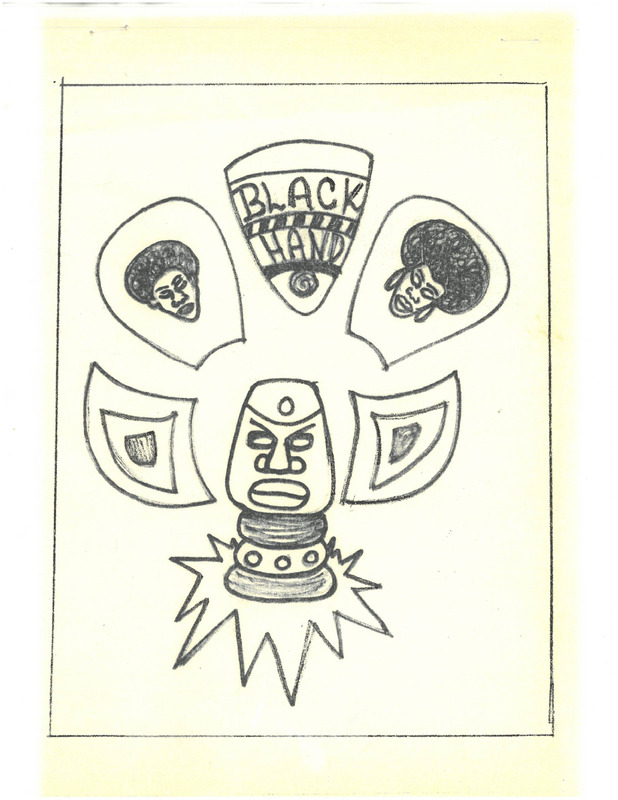
An issue of Black Hand, literary magazine and one of several publications dedicated to examining the Black experience at Dartmouth during the Civil Rights Movement. The staff briefing describes the publication as “allow[ing] us to reach further in that general direction of Blackness.” The staff elaborate that Black Hand is intended to be a tool for expression and a medium of communication and news dissemination.
-
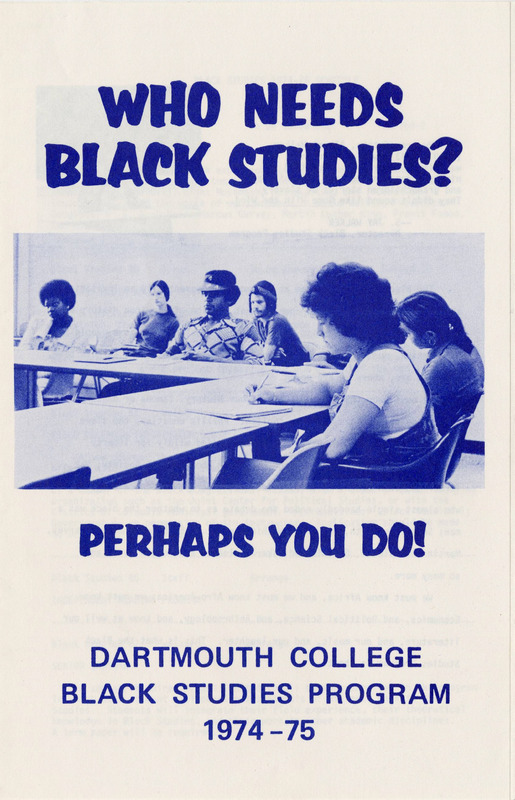
This pamphlet advertising the newly reorganized Black Studies Program depicts a classroom of diverse students. Dartmouth previously struggled over the decision to open Black Studies courses to the entire student body, or only to minority students. This publication demonstrates Dartmouth’s more concrete vision for the institution's Black Studies Program following the hiring of Black Studies Chairman S. Jay Walker in 1974.
-

This photograph in front of the Tuck School of Business depicts eighty-five eighth and ninth grade students alongside four instructors participating in Dartmouth’s summer ABC (A Better Chance) Program. The program aimed to prepare students from historically underrepresented backgrounds for the academic rigor of prestigious preparatory schools, and hosted talented students from across the nation throughout the 1960s.
-
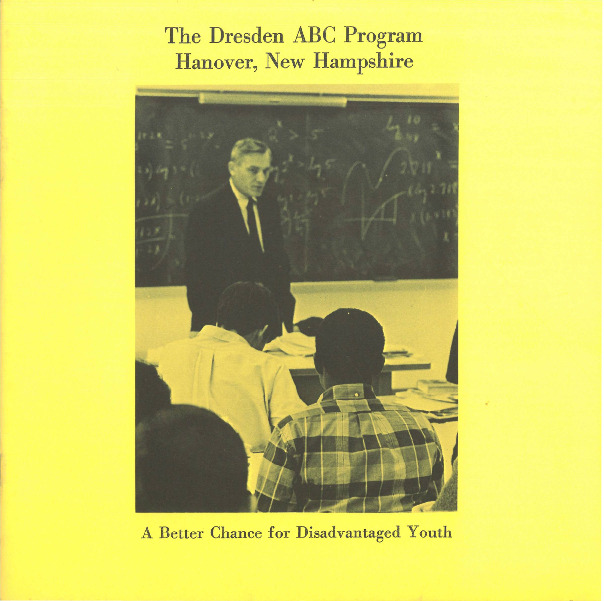
This pamphlet features eight high school students from historically underrepresented or disadvantaged backgrounds that attended Hanover High School in 1964 as members of the ABC (A Better Chance) Project, meant to diversify the pool of students enrolled in competitive preparatory schools and ultimately universities. Although the author asserts that ABC participants are similar to their peers at Hanover High, they emphasize the extra academic pressures that were undoubtedly placed upon ABC students, who were “expected to work harder... than most of their contemporaries.”
-

Printed by the Independent Schools Talent Search Program (ISTSP), this brochure outlines the admission process, living arrangements, and financial cost of attending summer ABC (A Better Chance) programming at Dartmouth (notice the photograph showing ABC students walking across the Dartmouth Green).
-
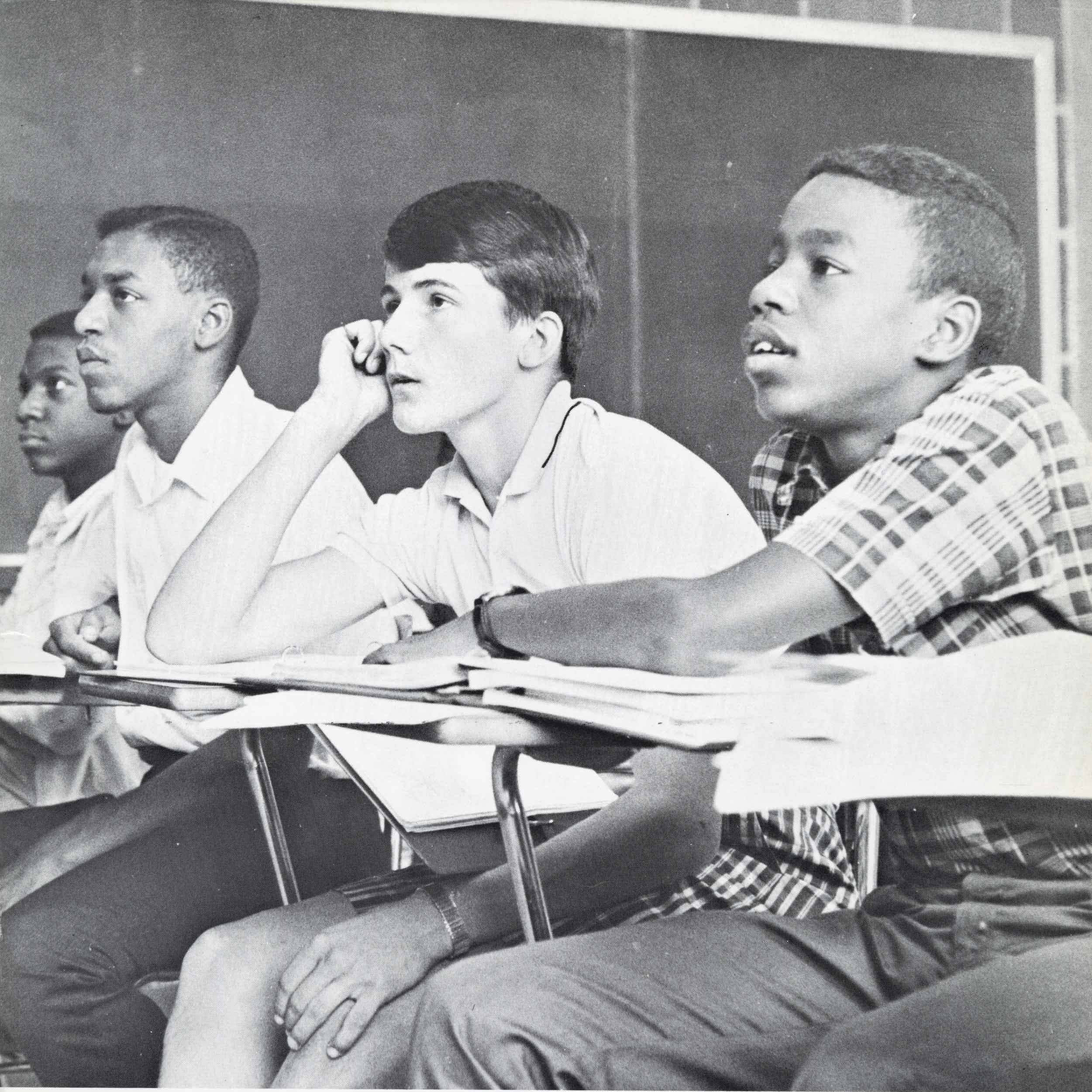
The cover of this booklet depicts four high school students attending lecture at Hanover High School as participants in ABC (A Better Chance), a program devised to equip disadvantaged students with the skills needed to succeed in highly competitive preparatory schools and future college applications. The booklets contents include descriptions of programming and typical program participants (e.g. students, tutors, and faculty), as well as reports for the 1966 operating year.
-
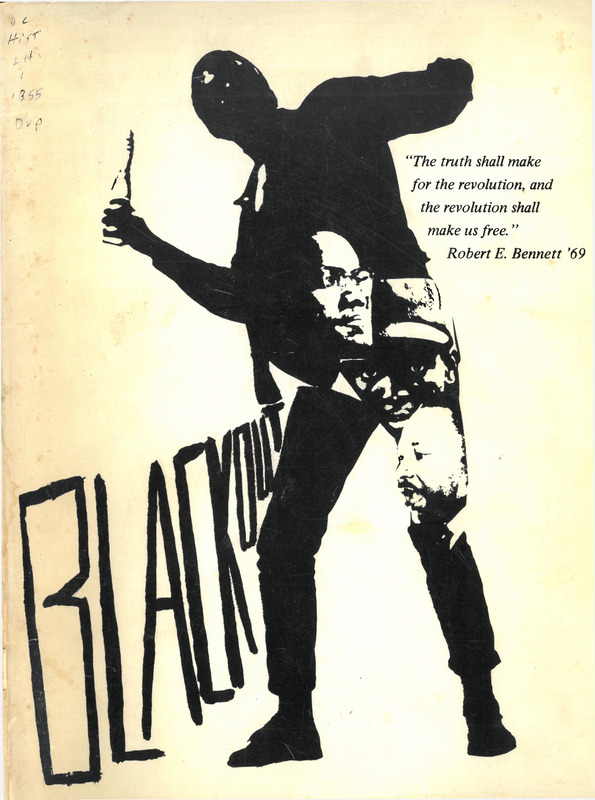
The second volume of Afro-American Society (AAS) student magazine Blackout, published in Spring 1968. The cover of this volume of Blackout depicts a protester poised to throw a Molotov cocktail, a nod to the revolutionary praxis of the Black Power Movement and Civil Rights leaders Dr. Martin Luther King and Malcolm X (their images are depicted in the protester’s silhouette). In ”Harambee,” the editors inform readers that this volume seeks to discuss the divergent sentiments underlying “newly developing black consciousness” (p. 49).
-
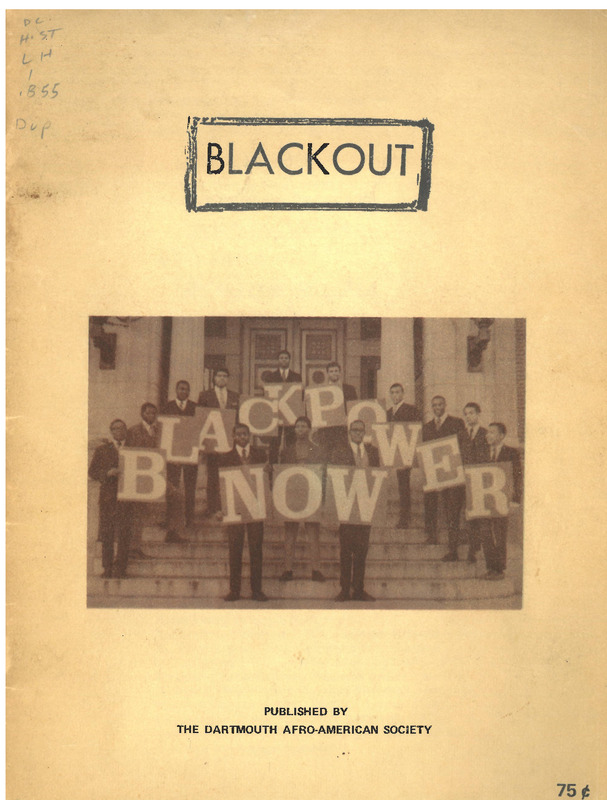
The first volume of Afro-American Society (AAS) student magazine Blackout, published in Fall 1967. The cover depicts AAS members holding signs that spell out “BLACK POWER NOW” on the steps of McNutt Hall, the home of the College’s administration offices. A highlight of this first volume is a photograph of Civil Rights leader Kwame Ture (Stokely Carmichael) and student Woody Lee ’68 (p. 41). The photo caption recounts how Ture’s impassioned speech inspired AAS members to take action in demanding “BLACK POWER NOW!”

























